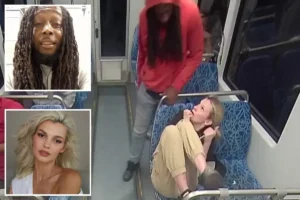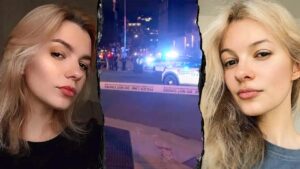Mystery Deepens in Iryna Zarutska Case: Family Reveals Enigmatic Handwritten Letter with Blacked-Out Page
In a stunning development that has reignited public interest in the tragic stabbing death of 23-year-old Ukrainian refugee Iryna Zarutska, her family has come forward with a three-page handwritten letter purportedly penned by Zarutska herself. Dated August 22, 2025—the very day she boarded the Charlotte light rail train where she would meet her untimely end—the letter offers a poignant glimpse into her final thoughts. However, the document’s last page is entirely obscured by thick layers of black ink, sparking widespread speculation about hidden messages, unspoken fears, or perhaps a deliberate attempt to conceal sensitive information. This revelation, shared by the family in an emotional statement, adds a layer of intrigue to an already heartbreaking story that has captured international attention and fueled heated debates in the United States.

Zarutska’s journey to America was one of hope amid despair. Fleeing the devastation of Russia’s invasion of Ukraine in August 2022, she arrived in Charlotte, North Carolina, with her mother, sister, and brother. Holding a degree in art and restoration from Synergy College in Kyiv, Zarutska was known for her creative spirit, often crafting personalized artwork for loved ones. In her new home, she enrolled at Rowan-Cabarrus Community College, aspiring to become a veterinary assistant, and worked at Zepeddie’s Pizzeria. Friends and family described her as a “homebody” with a radiant smile, someone who found joy in simple things like caring for neighbors’ pets and long, restorative sleeps—her “artist’s gift,” as her mother fondly called it.
On that fateful evening of August 22, Zarutska boarded the Blue Line light rail at Scaleybark station after her shift, dressed in khaki pants, a dark shirt, and her work hat, her long blonde hair tucked away. Surveillance footage, which later went viral, captured her sitting alone, engrossed in her phone—a typical scene for any commuter. Unbeknownst to her, Decarlos Brown Jr., a 34-year-old man seated nearby, would soon shatter the mundane routine. Four minutes into the ride, Brown, clad in a red sweatshirt, pulled out a pocket knife, glanced out the window, and lunged at Zarutska, stabbing her fatally in the face and throat. She clutched her wounds, slumped to the floor, and bled out as horrified passengers attempted to intervene. The attack, described as sudden and unprovoked, left the city reeling and highlighted vulnerabilities in public transit safety.
Brown, now charged with first-degree murder, has a troubled history that underscores systemic failures in mental health and criminal justice. Convicted previously for armed robbery, felony larceny, and breaking and entering, he served over five years in prison before his release in 2020. Family members revealed Brown’s long-standing battle with schizophrenia, marked by hallucinations, paranoia, and aggressive episodes. His sister, Tracey Brown, recounted an incident in 2022 where he attacked her, though she dropped charges out of concern for his well-being. Earlier in 2025, Brown called 911, claiming the government had implanted a chip in him, resulting in a misdemeanor charge. Despite these red flags, efforts by his mother, Michelle Dewitt, to secure long-term care failed due to legal barriers—she wasn’t his guardian. In a chilling post-arrest statement to his sister, Brown claimed he attacked Zarutska because he believed she was “reading his mind.”
The aftermath of the stabbing quickly transcended local news, becoming a flashpoint in America’s polarized political landscape. President Donald Trump seized on the incident to criticize Democratic-led cities, labeling Brown a “career criminal” on Truth Social and using it to justify federal troop deployments to Los Angeles and Washington, D.C., while threatening similar actions in Chicago. Conservative commentators amplified the narrative, portraying the attack as emblematic of lax crime policies. Pro-Trump activist Laura Loomer falsely alleged that no Black passengers assisted Zarutska—despite video evidence showing otherwise—and framed the event as evidence of “anti-white racism,” urging Republicans to make it a midterm election issue. These claims drew sharp rebukes, with many pointing out the misinformation’s role in exacerbating divisions.
In Ukraine, the killing evoked horror and disillusionment. Many viewed it as a stark reminder of the perils beyond war-torn borders. Lyubov, a 22-year-old Ukrainian in North Carolina, connected it to rising domestic violence homicides in the state, lamenting the lack of response from Ukrainian leaders like President Volodymyr Zelenskyy, who treated it as a U.S. domestic matter. Others, like political scientist Vyacheslav Likhachev, suggested Zelenskyy might eventually comment to court Republican support, risking backlash from Democrats. Kseniya Mikhalchuk saw symbolic parallels to U.S. inaction on Russia’s aggression, while Leonid Lemeshev decried America as “unsafe” due to gun violence and healthcare shortcomings. The false narratives from U.S. conservatives shocked Ukrainians, with students like Sofia Burlyuk criticizing the failure to fact-check amid ongoing cultural wars.

Compounding the tragedy, the graphic surveillance video of Zarutska’s final moments spread like wildfire across social media platforms, transforming a personal horror into public spectacle. Users dissected the footage—zooming in, slowing it down, adding annotations, and theorizing about motives—turning it into what critics call “cheap snuff films.” This phenomenon, as highlighted in recent commentary, desensitizes viewers and erodes empathy, with algorithms prioritizing outrage-inducing content. The video’s virality mirrored other incidents, like the shooting of conservative figure Charlie Kirk or a beheading in Dallas, illustrating a broader societal numbness to violence in the digital age. Public spaces, from schools to gatherings, now inadvertently expose people to such material, raising questions about the psychological toll on society.
Now, the emergence of the handwritten letter introduces a cryptic element that could reshape understandings of Zarutska’s last day. According to family statements shared via social media, the three-page document, written in shaky handwriting, was dated the same day she boarded the train—suggesting it was composed shortly before the incident. The first two pages reportedly contain personal reflections: expressions of love for her family, musings on her new life in America, and perhaps hints of her dreams for the future. Her mother, in a separate emotional note, spoke of Zarutska’s “smile that lit up the small kitchen,” evoking the warmth she brought to their home.
But it is the third page that has ignited a firestorm of speculation. Completely blanketed in black ink, it appears as though Zarutska—or someone else—intentionally obscured its contents. Was it a final confession, a warning about perceived dangers, or an unfinished thought she chose to hide? Some online theorists suggest it could reveal fears related to her refugee status, personal struggles, or even premonitions tied to her mental state that day. Others posit forensic possibilities: experts in document analysis might use infrared imaging or chemical treatments to uncover the text beneath, potentially unveiling clues about her mindset or undisclosed events leading up to the attack.
The family’s decision to release the letter, despite its enigmatic nature, stems from a desire for transparency and justice. In their first public statements, they expressed profound grief, emphasizing Zarutska’s resilience in fleeing war only to face violence in a land of supposed safety. Memorials at the East-West Boulevard station, adorned with flowers, candles, and handwritten notes reading “We failed you,” reflect community remorse. One such tribute underscores the collective failure: a system that allowed Brown, with his untreated mental illness and criminal record, to roam free, intersecting fatally with Zarutska’s path.

As investigations continue, calls for reform echo loudly. Charlotte Mayor Vi Lyles has highlighted court system shortcomings, while advocates push for better mental health resources and stricter oversight of repeat offenders. Zarutska’s story, now layered with this mysterious letter, serves as a poignant reminder of the human cost behind headlines— a young woman seeking refuge, cut down in her prime, her final words partially veiled in ink. Whether the blacked-out page holds secrets that could alter the narrative remains to be seen, but it ensures her memory endures, urging society to confront its failures in protecting the vulnerable.


